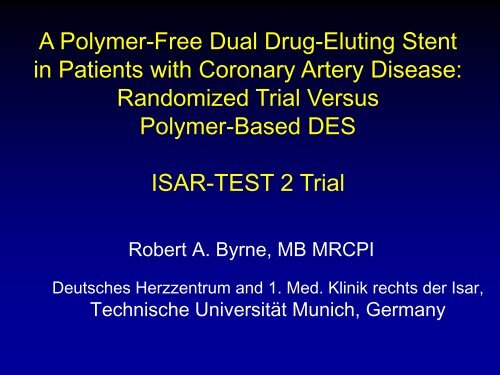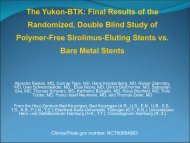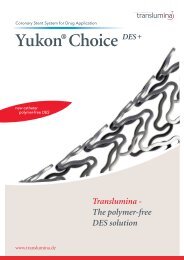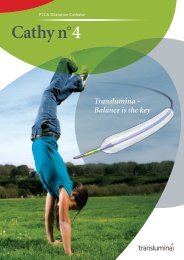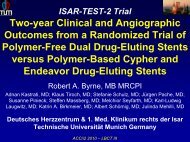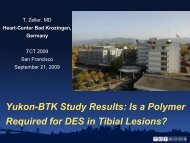Folie 1 - Translumina
Folie 1 - Translumina
Folie 1 - Translumina
Create successful ePaper yourself
Turn your PDF publications into a flip-book with our unique Google optimized e-Paper software.
A Polymer-Free Dual Drug-Eluting Stent<br />
in Patients with Coronary Artery Disease:<br />
Randomized Trial Versus<br />
Polymer-Based DES<br />
ISAR-TEST 2 Trial<br />
Robert A. Byrne, MB MRCPI<br />
Deutsches Herzzentrum and 1. Med. Klinik rechts der Isar,<br />
Technische Universität Munich, Germany
DISCLOSURES<br />
I have no conflicts of interest to disclose<br />
Robert A. Byrne
Background<br />
Long-term polymer residue in the coronary<br />
milieu is a consequence of current DES<br />
therapy and has been implicated in late<br />
adverse events<br />
Avoidance of polymer imposes certain<br />
efficacy limitations related to suboptimal<br />
release kinetics of the active drug
Background<br />
The incorporation of a second active agent<br />
targeted at a different element of the<br />
restenotic response cascade is a potential<br />
option to enhance anti-restenotic performance<br />
in a polymer-free DES
Background<br />
Previous experience with an oestradiol +<br />
rapamycin-eluting stent did not show<br />
improved anti-restenotic efficacy
Background<br />
JACC<br />
2007
Background<br />
Probucol is a potent lipophilic antioxidant<br />
which has proven effects in reducing<br />
restenosis – both in animal models and<br />
clinical trials<br />
We therefore developed a polymer-free<br />
probucol + rapamycin-eluting stent and<br />
sought to examine its efficacy in<br />
ISAR TEST-2<br />
Ferns Proc Natl Acad Sci 1992<br />
Schneider Circulation 1993<br />
Tardif NEJM 1997<br />
Tardif Circulation 2003
Aim of ISAR-TEST-2 Study<br />
to compare the anti-restenotic efficacy of:<br />
polymer-free probucol+rapamycin-eluting stent<br />
(Dual-DES)<br />
with<br />
permanent polymer rapamycin-eluting stent<br />
(Cypher)<br />
and<br />
permanent polymer zotarolimus-eluting stent<br />
(Endeavor)<br />
in patients with coronary artery disease
Inclusion Criteria<br />
‣ “De novo” lesions in native coronary arteries<br />
‣ Written informed consent<br />
Exclusion Criteria<br />
‣ Left main lesion<br />
‣ Cardiogenic shock<br />
‣ Comorbidities with a life expectancy < 12 months<br />
‣ Contraindication to aspirin, limus agents, probucol,<br />
stainless steel, thienopyridines<br />
‣ Pregnancy<br />
Patient Selection
ISAR-TEST-2 Endpoints<br />
Primary Endpoint:<br />
‣ in-segment binary angiographic restenosis (DS ≥<br />
50%) at follow-up angiogram<br />
Secondary Endpoints:<br />
‣ in-stent late luminal loss<br />
‣ need for target lesion revascularization due to<br />
restenosis in the presence of symptoms or signs of ischemia<br />
‣ composite of death and MI<br />
‣ incidence of stent thrombosis
Study DES Types<br />
• Probucol+rapamycineluting<br />
stent (Dual-DES)<br />
• Rapamycin-eluting stent<br />
with permanent polymer<br />
(Cypher)<br />
100 µm<br />
• Zotarolimus-eluting stent<br />
with permanent polymer<br />
(Endeavor)<br />
10 µm<br />
Microporous thin-strut (87 μm) 316L SS<br />
Polymer-free; dual drug-eluting<br />
Developed in setting of ISAR Project
Statistical Analysis<br />
Study hypothesis:<br />
Dual-DES, Cypher and Endeavor stents would have different<br />
anti-restenotic efficacy<br />
Assumptions:<br />
Power 80%; α-level of 0.05<br />
To detect difference in proportions characterized by:<br />
• average proportion of 11.7%<br />
• variance of proportions of 0.14%<br />
Needed sample size of:<br />
245 patients in each of three groups<br />
1007 patients enrolled to accommodate for possible missing<br />
follow-up angiographic data
Statistical Analysis<br />
Pre-specified analysis:<br />
In the event of a significant difference in the primary analysis,<br />
two pre-specified analyses were planned to be performed:<br />
Dual-DES versus Cypher<br />
Dual-DES versus Endeavor<br />
To account for multiple testing a p-value of
Study Flow Chart<br />
1007 pts randomized<br />
Cypher<br />
335 pts<br />
Dual-DES<br />
333 pts<br />
Endeavor<br />
339 pts<br />
61 no FU angiogram<br />
- 1 uTLR
Data are percentage or mean ± standard deviation; Percentages may not total 100 due to rounding<br />
Baseline Clinical Characteristics<br />
Cypher<br />
(n=335)<br />
Dual-DES<br />
(n=333)<br />
Endeavor<br />
(n=339)<br />
Age, years 67±11<br />
67±11 67±11<br />
Women 23 23 25<br />
Arterial hypertension 64 65 68<br />
Diabetes<br />
27<br />
29<br />
26<br />
Current smoker<br />
17<br />
20<br />
18<br />
Hypercholesterolemia<br />
69<br />
63<br />
66<br />
History of MI<br />
30<br />
25<br />
26<br />
History of CABG<br />
8<br />
10<br />
9
Data are percentage or mean ± standard deviation; Percentages may not total 100 due to rounding<br />
Baseline Clinical Characteristics<br />
Cypher<br />
(n=335)<br />
Dual-DES<br />
(n=333)<br />
Endeavor<br />
(n=339)<br />
Acute MI<br />
13<br />
12<br />
15<br />
Unstable angina<br />
25<br />
30<br />
30<br />
Stable angina<br />
61<br />
58<br />
56<br />
LV ejection fraction (%)<br />
52±12<br />
53±12<br />
55±10
Data are percentage; percentages may not total 100 due to rounding<br />
Angiographic Characteristics<br />
Cypher<br />
Dual-DES<br />
Endeavor<br />
Target vessel<br />
LAD<br />
LCx<br />
RCA<br />
49<br />
25<br />
26<br />
44<br />
25<br />
31<br />
41<br />
31<br />
29<br />
Multivessel disease<br />
86<br />
81<br />
83<br />
Complex lesions<br />
73<br />
70<br />
75<br />
Total occlusions<br />
12<br />
12<br />
12
Data are mean ± standard deviation<br />
QCA Measurements<br />
Cypher<br />
(n=419)<br />
Dual-DES<br />
(n=427)<br />
Endeavor<br />
(n=420)<br />
Vessel size, mm 2.75±.46 2.69±.52 2.71±.49<br />
Lesion length, mm 14.8±8.3 14.0±8.2 14.7±8.0<br />
MLD before PCI, mm 0.97±.46 0.93±.47 1.00±.49<br />
DS before PCI, % 64.7±15.0 65.4±14.6 63.4±15.9<br />
MLD after PCI, mm 2.55±.43 2.49±.48 2.51±.47<br />
DS after PCI, % 10.8±5.7 11.6±5.0 10.7±7.0
Primary Endpoint:<br />
binary angiographic restenosis<br />
p=0.68 p=0.003 p=0.002<br />
20<br />
%<br />
19.3<br />
15<br />
12.0<br />
11.0<br />
10<br />
5<br />
0<br />
Cypher<br />
Dual-DES<br />
Endeavor
Secondary Endpoint:<br />
in-stent late lumen loss<br />
p=0.78 p
QCA Measurements at FU<br />
Cypher<br />
(n=347)<br />
Dual-DES<br />
(n=356)<br />
Endeavor<br />
(n=343)<br />
Late lumen loss, mm<br />
In-stent<br />
In-segment<br />
MLD, mm<br />
In-stent<br />
In-segment<br />
Diameter stenosis, %<br />
In-stent<br />
In-segment<br />
0.24±.51 0.23±.50 † 0.58±.55<br />
0.23±.48 0.20±.52 † 0.35±.60<br />
2.32±.63 2.26±.64 † 1.95±.72<br />
1.99±.59 1.98±.59 † 1.79±.66<br />
20.1±16.8 20.0±17.1 † 30.0±21.2<br />
31.8±15.4 30.5±16.6 † 35.3±19.4<br />
†<br />
p
Restenosis<br />
Angiographic restenosis<br />
Clinical restenosis (TLR)<br />
p=0.68 p=0.002 p=0.83 p=0.001<br />
20<br />
19.3<br />
20<br />
% %<br />
15<br />
15<br />
12.0<br />
11.0<br />
10<br />
10<br />
7.2 6.8<br />
13.6<br />
5<br />
5<br />
0<br />
Cypher<br />
Dual-DES<br />
0<br />
Endeavor
Clinical Follow-Up at 1 year<br />
Incidence<br />
20<br />
%<br />
15<br />
10<br />
p=0.66<br />
p=0.80<br />
p=0.87<br />
5<br />
6.0 6.0<br />
6.2<br />
3.6<br />
4.2<br />
3.2<br />
0<br />
Death/myocardial<br />
infarctiom<br />
Myocardial<br />
infarction<br />
0.9<br />
0.9<br />
0.6<br />
Definite stent<br />
thrombosis<br />
Cypher<br />
Dual-DES<br />
Endeavor
Conclusions (1)<br />
‣ This is the first report of successful outcome<br />
with a Dual-DES<br />
‣ A novel probucol+rapamycin Dual-DES is<br />
associated with high anti-restenotic efficacy<br />
without recourse to permanent polymer
Conclusions (2)<br />
‣ The efficacy of this Dual-DES platform is<br />
superior to that of the permanent polymer<br />
zotarolimus stent and comparable to that of the<br />
permanent polymer sirolimus-eluting stent<br />
‣ Although avoidance of durable polymer has<br />
interesting potential long-term safety<br />
implications, durability of performance efficacy<br />
and accrual of putative clinical benefit remain<br />
subject to future investigation
Thank You<br />
Robert A. Byrne, ISAR Centre<br />
Deutsches Herzzentrum, Munich. Germany


